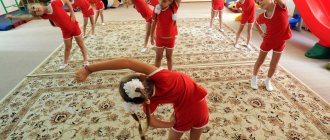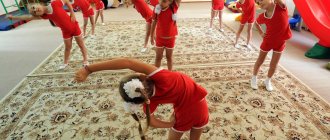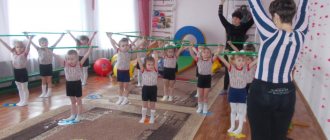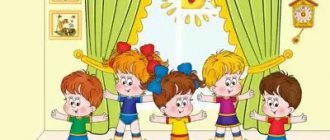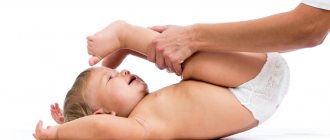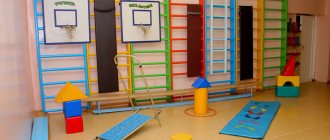Non-traditional forms of morning exercises in preschool educational institutions.
"Non-traditional forms of holding
morning exercises at preschool educational institutions"
The preschool period is the time when the foundation of physical, mental and moral health is laid. Among the many factors that influence the health and development of children, physical education occupies a special place in terms of intensity. In introducing children to a healthy lifestyle, their mastery of the basics of hygienic and physical education is of particular importance. The task of physical education of preschoolers is to form in them a stable habit of systematic physical exercise. Morning exercises play an important role in solving this problem. Although morning exercises in preschool educational institutions are short in time, they compensate for up to 5% of the daily volume of physical activity of children and are considered as an important element of the motor regime. Doing a set of morning exercises every day is the minimum physical activity that should become an element of every child’s personal physical culture. The special place of morning exercises in the daily routine is due to the important role that the transition from sleep to wakefulness, from rest to active activity plays in a person’s daily biological rhythm.
Analysis of previous work, the results of surveys and observations led to the conclusion that it is necessary to model morning exercises of a new type. Currently, many new methods of performing gymnastics have appeared. In order to increase children's interest in exercise, kindergarten teachers introduced non-traditional forms of morning exercises, such as:
— game stretching;
— step aerobics;
- gymnastics on fitballs.
Game stretching (application No. 3)
Game stretching
– these are specially selected muscle stretching exercises performed with children in a playful way. In other words, this is a creative activity in which children live in a world of images, often no less real to them than the surrounding reality.
The implementation of gaming opportunities for the health and development of the child is the essence of gaming stretching. Moreover, all classes are conducted in the form of a role-playing or thematic game, consisting of interrelated situations, tasks and exercises.
The method of play stretching is based on static stretching of the muscles of the body and the joint-ligamentous apparatus of the arms, legs, and spine, which allows one to prevent and correct postural disorders and have a profound healing effect on the entire body.
Exercises are performed without outside influence, because The human body is its own trainer. Self-manipulation of the body in a slow, and therefore safe, rhythm is most effective. In children, complexes associated with the physical imperfection of the body and the inability to control it disappear. In addition, children acquire a reserve of motor skills that allow them to feel strong, beautiful, self-confident, and create a sense of inner freedom.
Complex of morning exercises in the middle group “Snake and I are good friends!”
Complex of morning exercises using non-traditional equipment
“Snake and I are good friends!”
Fomina Victoria Vladimirovna
teacher
Name of the morning exercise complex:
“Snake and I are good friends!”
Age group:
middle group
Petrozavodsk urban district.
2017
A complex of morning exercises for the middle group.
“Snake and I are good friends!”
Equipment:
“hemp” (circles made of thick cardboard), “snakes” (green caps collected on a thread), tape recorder, recording the sound of a snake hissing, a cheerful musical composition.
Motivation of children:
- audio recording of snake hissing
- funny poem
- interesting non-traditional manual (“snakes”, “hemps”)
- the names of the exercises cover one topic
- low mobility game “A snake walked across the field”
- cheerful musical accompaniment
Introductory part:
Between the green grass,
Between old stumps, leaves and mushrooms,
Crawled, hissing into the bushes
The snake is a long string.
Walking in a column. Easy running. Walking like a snake, going around the “stumps”.
Children go around the “stumps”, at this time
The teacher turns on the sounds of a snake hissing and asks: “Who is that hissing?” (Children answer “snake”)
Main part:
- “Hello, snake!”
. I. p. - feet shoulder-width apart, hands folded behind the back. Take a breath. Lean forward. Exhale. Return to starting position. (1 - 2 times)
- “Pick up the snake.”
I. p. - stand with legs apart, “snake” at the bottom. 1 — lift the “snake” forward; 2 - up; 3 - forward; 4 - return to the starting position (5-6 times).
- “Put the snake down.”
I. p.: feet shoulder-width apart, “snake” below. Lean forward, lowering the “snake”, return to the starting position (5-6 times).
- “Show me the snake.”
I. p. - stand with feet shoulder-width apart, “snake” at the bottom. 1 — lift the “snake” forward; 2 - sit down, arms straight; 3 - stand up, “snake” forward; 4 - return to the starting position (5-6 times).
- "Jump over the snake."
I. p. - stand with legs slightly apart, arms at random, “snake” on the floor. Jumping on two legs over a snake. (5-6 times)
- Low mobility game “A snake walked across the field”
The “snake” walks in front of the players with the words: “The snake walked across the field and dropped its tail, (approaches one
of the players)
and then found it”
(touches the child’s “tail”).
The player must crawl between the legs of the “snake” and become its “tail”. And so on until all the children of the “tails” are collected.
Children take "snakes"
stand in a circle.
The “snakes” are placed on the stumps.
According to the counting rhyme, the driver is selected as a “snake”, and the rest of the guys are “tails” of the snake.
Final part:
Goodbye, snake! Crawl away quickly!
Your children are waiting for you
That's a loud name!
All the children, linked to each other (a long snake), walk around the hall. A short walk.
Breathing exercise
“We hiss like snakes”
Children say “sh – sh – sh – sh...”
The teacher turns on cheerful music.
Bibliography:
- FROM BIRTH TO SCHOOL. Basic educational program of preschool education / Ed. N.E, Veraksy, T.S. Komarova, M.A. Vasilyeva. – M.: MOSAIC-SYNTHESIS,
2015. - 368 p.
Photos of visual aids that were used during morning exercises.
Thematic morning exercises in the senior group
(Autumn)
Preschool childhood is a special period in a child’s life. It is at this time that the foundation of the health of the future adult is laid, physical qualities, motor abilities and skills are formed. The main tasks of preschool institutions are to protect and strengthen the health of the preschooler, his comprehensive, timely and harmonious development, and the functional improvement of the basic physiological systems of the child’s body. Morning exercises play an important role in the physical education system.
Gymnastics is a system of specially selected exercises that have a comprehensive effect on the human body, strengthening its basic functional processes, promoting its harmonious development and increasing vitality. Through gymnastic exercises, vital motor skills are formed. The beauty and precision of movements develops basic motor qualities - agility, speed, strength, endurance, flexibility.
In connection with the latest requirements and innovations in the development of preschool education, in our opinion, attention should be paid not just to exercises, but to sets of exercises connected by a common thematic meaning or plot. Our preschool institution has developed comprehensive thematic planning for the entire school year. In accordance with it, I developed complexes of morning exercises on topics where the material covered is consolidated.
The complex of morning exercises includes various types of walking and running in the first part, general developmental changes, breathing exercises in the second part, and final walking in the third part. At the beginning of the complex there is a small poem corresponding to the topic, this helps to mobilize the attention of children and tune their perception to a specific topic.
When conducting outdoor activities, I use various ways to organize children and types of formations (circle, line, columns) that correspond to their age abilities. Each exercise has its own name, is accompanied by a poetic text (literary word), and is performed with gymnastic equipment. Morning exercises are accompanied by musical accompaniment.
The complexes are aimed at normalizing muscle tone, correcting incorrect postures, developing static and dynamic endurance, an orderly pace of movement, synchronous interaction between movements and speech, memorizing a series of motor acts, developing speed of reaction to verbal instructions, developing coordination, and so on.
Children's clothing for morning exercises meets hygiene requirements: it is clean, light and does not restrict movement.
ORU complexes can be used during an evening walk, during physical education classes, and can also be included in separate fragments in different types of children’s activities throughout their entire stay in a preschool institution.
The methodological development is addressed to teachers of senior groups, heads of physical education and physical education instructors.
Topic of the week: “Child Safety Week”
Complex “On the way to kindergarten” (on the bench)
| № | Content | Dosage |
| 1 part | Formation in a line, alignment. Walking is normal, with small and wide steps. “Our children are going to kindergarten, our guys are in a hurry" Running is normal, with small and wide steps. “Little houses are running along the street, boys and girls are being taken to their houses" | 1 min. |
| part 2 | Formation in two columns near the benches (we get on a bus, tram, trolleybus). | |
| 1. | Traffic light. IP: sitting astride, legs bent, arms to the sides. IN.: “If the light turns red, it means it’s dangerous to move.” raise your arms up, cross them over your head, in an i.p. IP: sitting astride a bench, hands on the shoulders of the person in front. | 6-8 times |
| 2. | V.: “The green light says - go ahead, the path is open” turn to the right, moving the right hand back across the side, in the i.p. Same to the left. | 3-4 times |
| 3. | Bike. IP: the same. IN.: “I roll on two wheels, I spin with two pedals” raise both legs up alternately 3-4 times, simulating riding a bicycle, in an i.p. | 3 times |
| 4. | Trolleybus. IP: sitting astride, arms up (horns on a trolleybus). V.: tilt to the right (left), in i.p. (sharp turns). | 3-4 times |
| 5. | Bridge. I.p.: standing facing the bench, feet on the shoulder, hands down. V.: lean forward, put your hands on the bench, in the i.p. I.p.: legs on the waist, hands on the belt. | 6 times |
| 6. | Crosswalk. V.: jumping on two legs around a bench (one circle) and walking in the opposite direction. Breathing exercise on the exhale. (Exercise promotes large vibrations of body tissues, stimulates metabolic processes, increases energy, improves blood flow in the body and phlegm discharge.) | 2x20 4 times |
| Part 3 | Line up in one column, walk calmly. “We need traffic rules Carry out without objection! | 30 sec. |
Theme of the week: “Golden Autumn”
Complex “Autumn Harvest” (with a small ball)
| № | Content | Dosage |
| 1 part | Line up in a column, walk normally, raising your knees high, with an extended step. “The harvest has grown in the field, gather it quickly. Little children are driving along the ok path, Over bumps, over hummocks, over stumps and stumps.” Running is normal, side gallop, snake. “We flew like an arrow along the path in a straight line!” | 1 min. |
| part 2 | Children take a ball from the basket and line up in 2-3 columns. | |
| 1. | Fruits. I.p.: standing with your feet together, hands down. V.: raise your hands up, lower the ball behind your head “We picked fruit from the trees,” raise our hands up, lower them down, “And we filled the baskets.” | 6 times |
| 2. | Peas. I.p.: kneeling, ball in both hands at the top. V.: body tilt to the right, left. “We have collected onions and peas - our harvest is not bad!” | 3-4 times |
| 3. | Turnip. I.p.: standing with feet on sh.p., hands up. V.: tilt the torso down, touch the ball to the floor, “They took out a round turnip and almost fell to the ground,” in IP. | 6-8 times |
| 4. | Tomatoes. IP: standing (sitting) on your knees, the ball pressed to your chest. V.: turn to the right (left), hands forward “The tomatoes were torn together and scattered into buckets,” in i.p. | 3-4 times |
| 5. | Zucchini. I.p.: sitting, legs together, the ball sandwiched between the feet, arms pointing back. V.: Raise your legs up, lower them. “Here is a pot-bellied zucchini - rested his head." | 6 times |
| 6. | Watermelons. IP: sitting cross-legged. V.: toss and catch the ball. "We collected watermelons and they threw them into the car.” | 10 times |
| 7. | I.p.: ball in the right hand below, left on the belt. V.: 5 jumps on the right leg, 5 on the left, 5 on two legs, “Here is a hill, there is a ravine - take a shorter step!” alternate with walking in place (15). | 2-3 times |
| Breathing exercise “Blow on a berry . | 4 times | |
| Part 3 | Line up in one column, walk calmly. “We’re going, we’re going home in a truck. Open the gate, the harvest is coming from the field!” | 30 sec. |
Topic of the week: “Animal world” (wild animals)
Complex "Wild Animals"
| № | Content | Dosage |
| 1 part | Formation in a column, normal walking, small “spiders” and wide “crocodiles” steps. Running is normal, side gallop, snake. | 1 min. |
| part 2 | Children line up in 2-3 columns. | |
| 1. | "Crocodile". I. p. – feet shoulder-width apart, arms along the body. V.: Smoothly raise your right (left) hand up, left (right) back, bend slightly, in and out. p. “The crocodile snapped its mouth, it almost swallowed us.” | 6-8 times |
| 2. | "Monkey". I. p. – feet shoulder-width apart, hands on the waist. V.: Tilt the torso to the right (left), bend your arms at the elbows, palms forward, fingers spread wide, in i. p. “The monkeys got wild and shook all the vines.” | 3-4 times |
| 3. | "Turtle". I. p. - squat, palms on the floor. V.: Stepping forward with your arms, straighten your legs, head straight; in and. p. “The big turtle crawls without fear.” | 6 times |
| 4. | "Spider". I. p. - o. s., hands down. V.: 1 - hands up, clap above your head; 2 – tilt the torso forward, clap behind the legs; 3 - in i.p. “A big spider is weaving a web, and it caught it on a branch.” | 6 times |
| 5. | "Parrot". I. p. – feet shoulder-width apart, hands on the waist. V.: Raise the right (left) leg, bent at the knee, pulling the toe; slap your palms on your knees, in and. p. “The parrot does not know laziness - he raises his knees.” | 3-4 times |
| 6. | "Boa". I. p. - legs on the shp, hands in a “lock” on the back of the head. V.: Raise your arms up, palms out, turn to the right (left) in i. p. “The long boa constrictor straightened out its coils and forced us to hide behind the bushes.” | 3-4 times |
| 7. | "Hummingbird" I. p.: standing, legs together, hands on the belt. V.: Jumping on two legs “Hummingbirds are flying, fluttering above us ,” alternate with walking in place “In the jungle there are no roads or paths, it is difficult for people to pass through the jungle.” | 3 x 20 |
| Breathing exercise "Elephant" I. p.: standing, legs slightly apart, arms down. V.: Inhale through your nose, and as you exhale, raise your hand up (trunk) and pull it out in a long manner: “Oooh.” | 4 times | |
| Part 3 | Line up in one column, walk calmly. | 30 sec. |
Topic of the week: “Home, furniture, dishes”
Complex “Let’s go for a visit” (in pairs)
| № | Content | Dosage |
| 1 part. | Formation in a line, alignment. Walking is normal. “Today we are going with you to visit Olya, to visit Vanya,” with an added step, “We are going for a long, long time. We’ll step over all the puddles.” The usual running, scattered in pairs, “Let’s all get on the bus and rush along the highway.” | 1.5 min. |
| Part 2. | Formation in pairs scattered. | |
| 1. | "High House" IP: standing facing each other, hold hands. V.: Raise your arms to the sides, up, in an i.p. | 6-8 times |
| 2. | "Opening the doors." IP: standing with your back to each other, close, feet on the shoulder, hands down. V.: turn one child to the right, the other to the left, slap the friend’s palm, look at the friend, say “Hello!”, in i.p. Change direction. | 3-4 times |
| 3. | "We're taking the elevator." I.p.: standing facing each other, feet on sh.p., holding hands. V.: one child squats down, the other stands. The first child stands up, the second squats. | 6 times |
| 4. | “Let’s sit down at the table.” I.p.: sitting facing each other, legs wide apart, feet connected, holding each other’s hands. V.: in turns, the children pull each other towards themselves, leaning back. | 4 times |
| 5. | "Rocking chair". IP: sitting with your back to each other, holding hands, arms to the sides. V.: bend to the sides, touching the floor with your palms. | 4 times |
| 6. | “Wave to a friend through the window.” IP: the same, arms to the sides. V.: lean forward and down, bring your head closer to your feet, look at your friend, wave your palm, say “Hello!”, etc. "Jumping" | 6-8 times |
| 7. | IP: standing facing each other, holding hands. V.: jumping on two legs, moving in a circle, alternate with walking in a scattered pair. | 3 x 20 |
| Breathing exercise “Wind”. Standing facing each other, the children inhale through their noses and blow on each other as they exhale. | 4 times | |
| Part 3. | Calm walking in pairs. | 30 sec. |
Theme of the week: “Toys”.
Complex “Toys” (with gymnastic stick)
| № | Content | Dosage |
| 1 part. | Formation in a line, alignment. Walking is normal. Walking with your knees high. Running in all directions. Running like a snake. | 1 min. |
| Part 2. | Formation in 3 columns. | |
| 1. | "The rocket has flown" I.p.: standing feet together, stick in straight hands below. V.: raise your arms up, while simultaneously placing your leg back on your toes, in an i.p. | 6-8 times |
| 2. | "Let's rock the doll" I.p.: standing with your feet on your shoulder, a stick horizontally in both hands below. V.: raise your arms to the right (left) up, in the i.p. | 3-4 times |
| 3. | "Vanka-Vstanka" I.p.: stand with your feet on the shp, stick behind your head, on your shoulders. V.: tilt left and right. | 3-4 times |
| 4. | "Car rides" IP: sitting legs apart, stick in front of chest. V.: turns the body left and right. | 3-4 times |
| 5. | "The caterpillar is crawling" I.p.: Sitting, legs bent at the knees, feet standing on a stick, arms pointing back. V.: The legs “walk” forward along the stick, in the i.p. | 6 times |
| 6. | "The boat is sailing" IP: lying on your stomach, legs together, arms with a stick extended forward. V.: alternately raise your arms up, then your legs (sway on your stomach) 3-4 times. | 4 times |
| 7. | "Losharik" I.p.: Standing with your feet on your shoulder, hands below, stick on the floor. V.: Jumping on two legs over a stick back and forth, alternating with walking in place. | 3x20 |
| “The locomotive is humming” Breathing exercise. | 4 times | |
| Part 3. | Calm walking. “We do exercises in the morning - We will always be healthy!” | 30 sec.. |

